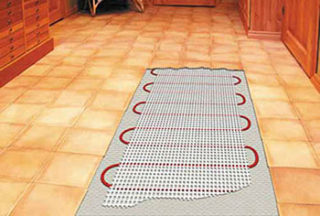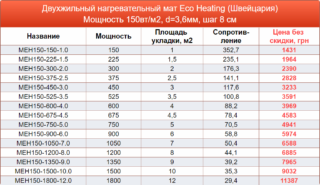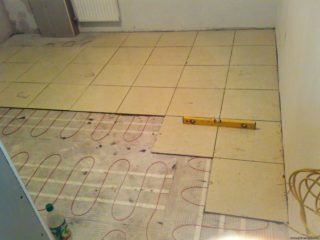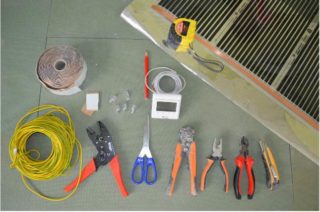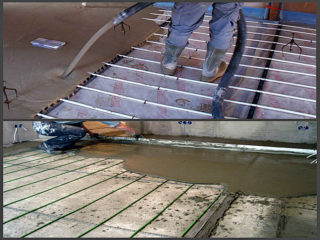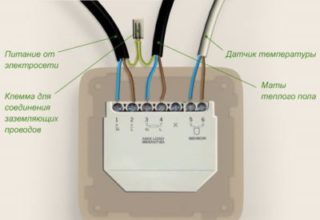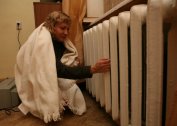To build an electric heated floor under the tile with your own hands, you need to familiarize yourself with some details of its arrangement. They include both the choice of the method of electric heating, as well as the preparation of a reliable foundation. In addition, the user will need to understand the methods for calculating the power of electric floors of the selected type.
Possible options
Electric floors are divided into the following types:
- heating cable systems;
- underfloor heating based on IR films;
- heating mats.
Under the tiled finish, the first and third varieties are best suited. Heating mats and a heating cable have a similar device, differing only in structural details. When meeting them, they pay attention to the following nuances:
- Cable for underfloor heating goes on sale in the form of bays of a given length, characterized by thermal return.
- Electric mats are made by laying the cores of the same cable on a preformed base. It is wound with a certain step and has a heat transfer corresponding to the number of turns.
- Infrared systems are equipped with IR films, at the edges of which there are electrical contacts for connecting power.
To determine the number of cables, mats or IR plates needed for flooring, you need to calculate the total power sufficient to heat the house.
Calculation of the power of underfloor heating
You can start the installation of an electric heated floor under the tile after determining the power required to heat one room and all rooms. To find this indicator, it is most convenient to proceed from data obtained experimentally. To heat 1 square meter of area, a cable electric heater with a capacity of about 140-180 watts is required. Based on this indicator, you should select the desired length of the heating cable, having familiarized yourself with its passport data.
When choosing a film heating coating, it should be assumed that the required power in this case is on average 150-220 W / sq. meter.
When choosing any option, it is also important to determine the electric power that the elements of the warm floor will consume from the home electrical network.
Preparatory stage
Before you make electric heated floors for tiles with your own hands, you need to prepare a reliable foundation. It can have the following designs:
- wooden (parquet) floor;
- concrete pouring;
- reinforced concrete floor slabs.
Preparatory measures come down to their alignment and placement of structural elements on which cable, mats or IR films are subsequently mounted. If necessary, it is necessary to insulate the base. You should also worry about purchasing all the necessary equipment and prepare a tool, without which it is impossible to install a heating system.
Tools and materials
When arranging a warm floor, the following electrical installation tool will be required:
- side cutters for cutting wires and stripping insulation, a screwdriver and pliers;
- a soldering iron used to tin bare ends, as well as solder and flux;
- for cutting through the strob in the floor and wall, you need a grinder with a stone disc or a perforator;
- for the continuity of electrical circuits should be stocked up with a measuring device - a multimeter.
In addition to electrical operations, construction work is ahead, during which devices will be required to prepare and level the screed. In addition to a drill with a nozzle, a standard set includes a capacious container and a full set of leveling tools:
- ordinary and serrated spatulas;
- rule of the desired length;
- rollers and brushes for applying and leveling the primer;
- devices for marking and surface control: tape measure, construction level, ruler and markers.
From materials, it will be necessary to purchase elements of the heated floor of the selected type in appropriate quantities, as well as hardware and components for leveling the base (screed preparation).
Filling screeds and laying tiles
To increase the heat transfer, the heating cable for the tile is often mounted directly in the cement fill. When arranging it, the following options are possible:
- wet screed made on the basis of cement composition with the addition of various plasticizers and fiber;
- semi-dry mixture obtained by limiting the amount of water in its mass;
- dry screed, prepared on the basis of ready-made mixtures containing small expanded clay granules or slag fragments.
The thickness of the electric underfloor heating installed in the screed is usually set in the range from 3 to 5 cm. It is not recommended to violate these indicators for reasons of safety of operation of the heating structure. Laying tiles on a ready-made electric floor is allowed only after the screed previously filled in has completely dried - after four weeks.
Floors without screed
The design of heating mats and heating cables does not exclude the possibility of laying them without a screed. The assortment of electric type underfloor heating offered by the market includes samples with a flat and very thin cable. It is laid directly on the concrete base, and then fixed by means of the hardware supplied with the kit. A step-by-step procedure for arranging an electric floor allows laying ceramic tiles on top of a securely fixed cable or flat mats. Sometimes, as a substrate under it, moisture-resistant multilayer plywood is used.
Mains connection
To connect electrical elements laid in a tiled floor that is equipped with a tile, you will need to select a separate power line. It must be protected with a circuit breaker, for reliability, an individual RCD must be connected in series with it. Before the start of electrical work, you should determine the zone for connecting the warm floor. To do this, you will need to select a site for installing a thermostat in a convenient place on the wall, to which the power line of the heating system is connected.
In rooms with high humidity, the thermostatic control unit is moved to another room or corridor, where there is free access to it.
A control unit with a thermal sensor is purchased separately; only in rare cases is this device included in the delivery. In this case, as a rule, no difficulties arise, since all the blocks have standard sizes and are easily mounted on a standard socket. The advantages of this option include the ability to choose any sample you like from the range offered by the market. This may be the simplest electromechanical model or a modern electronic control module having the option of programming operating modes.
